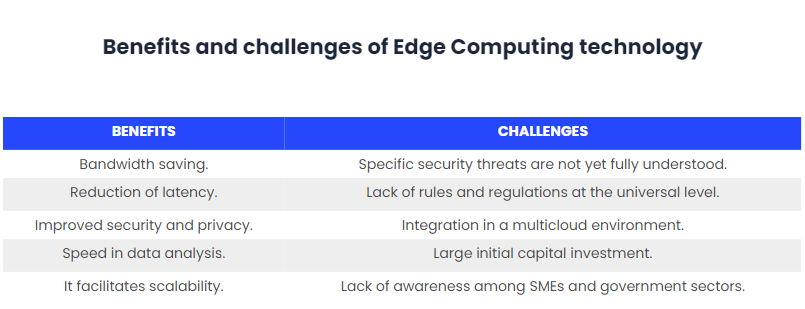Edge Computing in the 5G era, is it better if you work together?

Edge Computing technology is transforming the way data is treated, processed and delivered from millions of devices around the world. The exponential growth of Internet-connected devices, the Internet of Things (IoT), along with new applications that require computing power to handle real-time data, continue to drive leading-edge computing systems.
Increasingly fast network technologies, such as 5G technology, allow computer systems to accelerate the creation or support of real-time applications, such as video processing and analysis, autonomous cars, Artificial Intelligence or robotics.
While the primary objectives of edge computing were to address the bandwidth costs for the growth of data generated by IoT, the increase in real-time applications that require edge computing processing will further drive the technology.
Edge Computing: behind the fourth industrial revolution
In recent years, and more recently in the aftermath of the Covid-19 pandemic, Edge Computing has become more evident and has come to the fore as a necessary pillar of network architecture to support the new workforce and effectively leverage the growth of devices and sensors. In fact, it is estimated that the edge computing market will grow by 157%, generating revenues of $7.23 billion by 2024, up from $64.1 billion in 2019. It is estimated that around 90% of industrial companies will use this technology by 2022, mainly because it offers shorter latencies, stronger security, more responsive data collection, and lower costs.

Edge Computing is a type of cloud computing that allows IoT devices and web applications to run faster, ultimately reducing bandwidth pressure and network congestion to improve service quality and resilience. With this technology, information can be managed at high speed on the device itself and operational settings can be implemented in real time. As networks become increasingly congested with large volumes of real-time data generated by users, mobile and IoT devices, IT leaders say Edge Computing produces better performance, greater efficiencies and knowledge, leading to better business results.
What about 5G?
The 5G brings a radical change in connectivity. It is a rapidly growing technology on a global scale, and leading companies are already benefiting from this technology, as 5G dramatically increases video conferencing capabilities, Augmented Reality (AR), Virtual Reality (VR), Internet of Things (IoT), Artificial Intelligence as a Service (AIaaS), autonomous vehicles, e-Commerce, eHealth, including telemedicine.
Driven by the emergence of new computing applications and the emergence of the Internet of Things (IoT), the 5G network is expected to face an unprecedented increase in traffic volume and computing demands. However, most end users have limited storage and processing capabilities, so how to run resource-intensive applications on users with limited resources has become a major concern. Edge Computing technology can be a key to solving this problem.
While Edge Computing has been around for some years, the emergence and implementation of 5G has made it more relevant than ever. 5G will inevitably increase the amount of data being transferred across networks, and it is crucial that the connection using this technology is fast, secure and reliable.
With 5G becoming more ubiquitous, it is now increasingly feasible and critical for companies across a range of industries to adopt an edge computing strategy that enables them to manage, optimise and run their IT environments anywhere.
The 5G a catalyst for Edge Computing
The proliferation of 5G networks, which will significantly increase bandwidth and facilitate the transmission of large volumes of data, opens up a number of opportunities for Edge Computing applications.
Because 5G will help combat latency with its distributed architecture, companies will be able to use these networks to expand their own edge computing and move data much more efficiently. Instead of having to send that data to a centralised server, 5G networks will allow them to process that data closer to where it was created.
5G and Edge Computing are two technologies that are closely linked, as both are set up to significantly improve application performance and allow large amounts of data to be processed in real time. Together, they can improve Augmented and Virtual Reality for events, video and voice analysis, security video monitoring and much more. This combination is revolutionary for businesses as it can dramatically reduce latency and increase speed and security.
For 5G to provide accelerated network speeds, it requires lower latency and high interconnection that can be achieved through edge computing. The combination of 5G and Edge Computing will provide consumers and organisations with improved data processing, local data centre storage and sharing of computing power, energy efficiency at both network and device level, resilience, security, and optimal work allocation.
In addition, Edge Computing will play a key role in changing network security. The faster connections and greater interconnectivity provided by 5G also mean improved connections for cybercriminals.
Use cases combining both technologies
Reduced latency, increased speed and security are the reason why early use cases tend to involve technologies such as Augmented and Virtual Reality, Artificial Intelligence and robotics, as they require decisions by IT resources in a fraction of a second. But there is a possibility that a wider variety of commercial applications will benefit from both Edge Computing and 5G.
Experts cite a variety of use cases for Edge Computing in combination with 5G in the enterprise, including:
- Companies in the manufacturing, oil, gas and energy sectors that use 5G and Edge Computing for maintenance and repair activities. This includes RA/RV applications to guide technicians through the repair process, as well as drones for railway line, bridge or building inspections that use advanced analysis to identify potential defects or items that need maintenance.
- Real-time process optimisation in manufacturing facilities. Data generated from connected devices can dynamically adjust calibration settings, increasing performance and reducing potential problems.
- Monitoring of the state of the machinery by using IoT sensors to verify certain parameters in an asset or machine to ensure that it is functioning correctly.
- Real-time security video analysis to determine, for example, whether a person entering a building is an employee or a visitor, and to confirm the identity of employees.
- Use of real-time video and analysis to diagnose a patient or to perform remote monitoring of the patient.
Conclusions
The deployment of 5G networks and high-capacity edge computing will become an engine for an avalanche of new opportunities and business models. Innovation in both technologies will lead to the transformation of data that will change the way business is done and lead to an increase in innovations and services that will revolutionise the industry.
The ability, with the help of 5G, to easily deploy sensors, smart devices or robots everywhere, combined with low-latency or non-latent edge computing capabilities, provides a wealth of new opportunities, which were previously relatively costly to establish.
Edge Computing combined with 5G creates opportunities to enhance digital experiences, improve data performance and security, and enable continuous operations in any industry. So, should companies combine these technologies? Yes, the combination of 5G and Edge Computing will generate a level of innovation that will fundamentally change how work is done and how companies operate.

